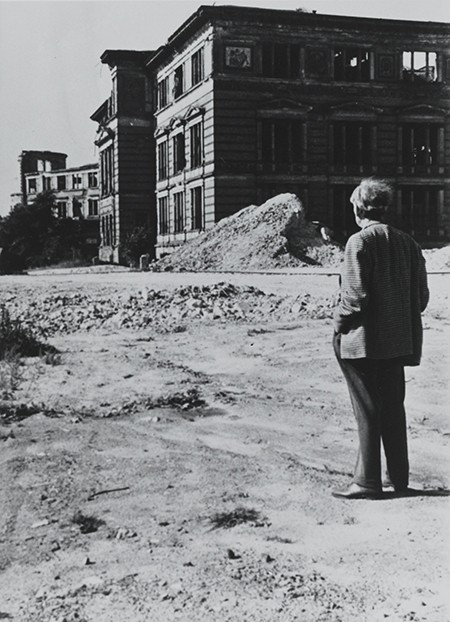The architect Walter Gropius (1883–1969) had an enduring relationship
with the city of Berlin. Gropius’s upper-middle-class Prussian family had contributed significantly to the fabric of the city: his great-uncle designed the Berlin Kunstgewerbemuseum (1881), and his father was a planner and city inspector. In the 1890s the family moved into a flat on the posh Kurfürstendamm. From this newly built yet overstuffed, neohistoricist home, Gropius witnessed the transformation of the Wilhelmine metropolis: the introduction of the electric tram and automobile, the growth of mass production, and the development of new building types, from the kiosk to the department store. The sights, sounds, and materiality of thechanging city left their mark on him; like the theorist Walter Benjamin (1892–1940), Gropius lived a true “Berlin childhood.”
During the years 1908–1914, Gropius worked first for the architect Peter Behrens (1868–1940) in Berlin and then started his own firm; in both contexts he designed factories and objects for mass production. At the University of Berlin, he attended the popular lectures of the urban sociologist Georg Simmel (1858–1918), whose ideas about money, the division of labor, and the relationship of external form to the modern intellect and the individual soul are directly reflected in Gropius’s earliest writings on the relationship between architecture and the industrial worker.
At the end of World War I, as a disillusioned soldier, Gropius returned to Berlin to take part in the German revolution, writing: “We artists, too, must strike while the iron is hot.” Some of his most profound writings about the role of art in creating a new society were composed in Berlin during the heady months of 1918–1919, demonstrating a class consciousness that is often dismissed. A decade later, while leading the Dessau Bauhaus, Gropius created a stunning series of designs for a new Berlin theater for Erwin Piscator (1893–1966), a leftist playwright and frequent collaborator with Bertolt Brecht (1989–1956). Gropius’s proposal incorporated film projections and a rotating, interactive stage—features that reflected his awareness of the political potential of the new media. In 1930 Brecht and Benjamin hoped that Gropius would collaborate with them on their planned activist journal Krise und Kritik. Neither the theater nor the journal, however, would materialize.
After leaving the Bauhaus in 1928, Gropius opened his second architectural firm based in Berlin. Often in collaboration with former Bauhaus faculty and students, he designed houses and housing complexes, furniture, automobiles, and a number of significant architectural exhibitions. His works from these years embody what Siegfried Kracauer (1889–1966) and other writers characterized as an exhilarating metropolitan mass culture based simultaneously on alienation and distraction. Rather than any one place, however, it was the peripatetic nature of Gropius’s life that ultimately shaped his oeuvre.
In the 1920s Gropius was forced by protofascists to move from Weimar to Dessau to Berlin. His architecture was denigrated as Semitic and Bolshevist—not German enough. In 1936, after a confrontation with Nazi authorities, he left Berlin for good, living first in London, and then settling in Massachusetts, where he joined the architecture program at Harvard University in Cambridge. In 1947 he returned to Berlin as a U.S. citizen and special envoy to the American military, asked to assess the bombing and offer recommendations for reconstruction. His tour included the destroyed remains of the Kunstgewerbemuseum; Gropius wrote to his wife that Berlin was a “desecrated corpse.” Working with The Architects Collaborative, for the remaining decades of his life he designed projects all over the world, including a renewed yet now divided Berlin, among them the extensive residential complex Gropiusstadt, which opened in 1960.
Too often, Gropius’s publications are studied in isolation, while his designs are named by many as representative of an imagined international style. A reliance on master narratives flattens the ambiguities inherent in his life—or any life. What if we look more deeply at this tumultuous historical context and consider Gropius as a serious thinker whose writings and designs are reflected in one another and whose ideas are tied to cultural criticism and aesthetic theory? The documents and photographs that I examined during my CASVA fellowship—in the Smithsonian Archives of American Art, the National Archives, and the Library of Congress—support such an alternative analysis. My study places Gropius’s architecture and essays on a trajectory of shifting modernities: wars and revolutions, exile and transience, technology and the rapid expansion of scientific inquiry—underscoring his acculturating definitions of the architect as a public humanist. As we navigate the ramifications of ongoing wars and refugee crises as well as renewed xenophobic cultural critique, my forthcoming book also contributes to debates about the role of the artist and intellectual in defining the concept of “home” when things fall apart.
